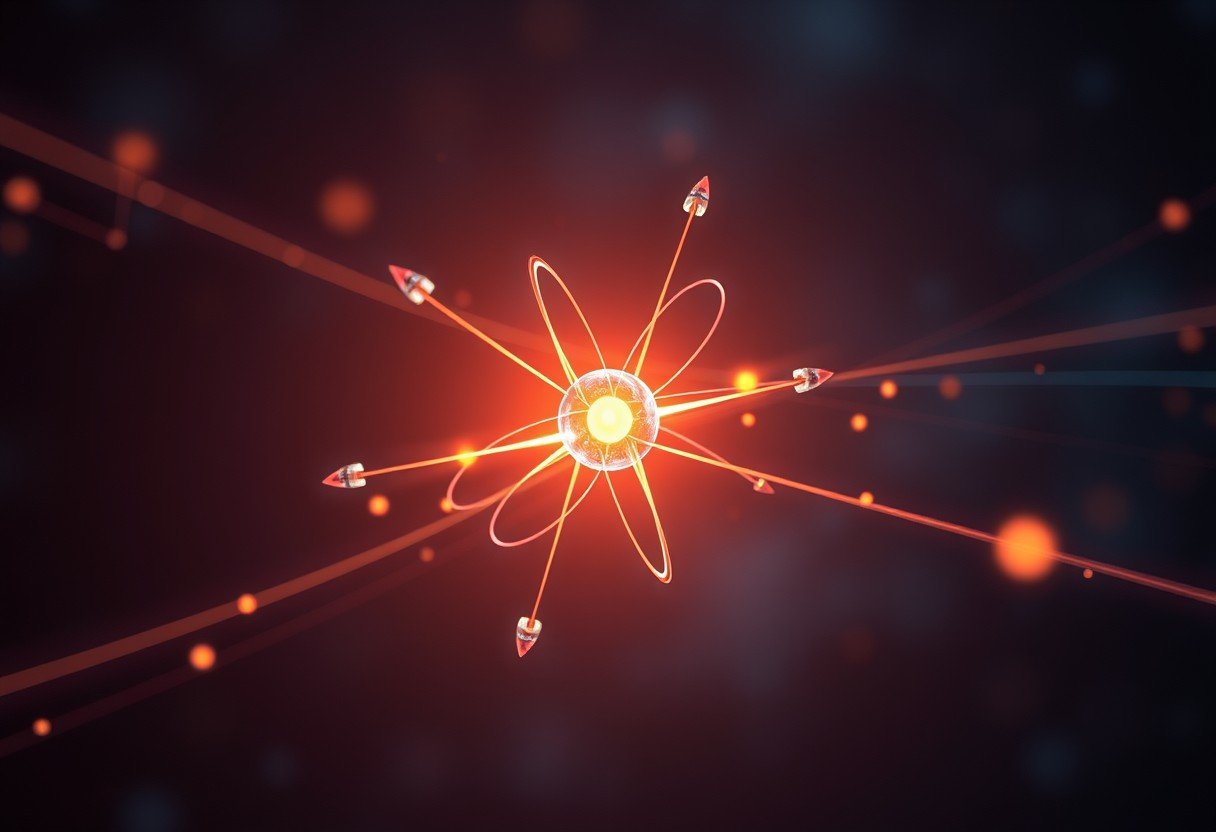Over time, you may have encountered the fascinating concept of wave-particle duality, particularly when it comes to electrons. One key aspect of this theory is the de Broglie wavelength, which defines the wavelength associated with a moving particle. As you research deeper into quantum mechanics, understanding how an electron’s momentum affects its de Broglie wavelength becomes crucial. This blog post will guide you through the relationship between electron momentum and its corresponding wavelength, providing a clearer insight into the behavior of subatomic particles in your studies.

Key Takeaways:
- De Broglie Wavelength Formula: The de Broglie wavelength (λ) is calculated using the formula λ = h/p, where h is Planck’s constant and p is the momentum of the electron.
- Inverse Relationship: As the momentum (p) of the electron increases, the de Broglie wavelength (λ) decreases, indicating an inverse relationship between the two variables.
- Momentum and Velocity: An increase in momentum typically results from an increase in the electron’s velocity, which in turn contributes to a shorter wavelength.
- Quantum Implications: The change in de Broglie wavelength has significant implications for the wave-particle duality of electrons, influencing their behavior in quantum mechanics.
- Applications: Understanding the change in de Broglie wavelength with momentum is crucial in fields like electron microscopy, quantum computing, and semiconductor technology.
The Concept of De Broglie Wavelength
As you investigate into quantum mechanics, the concept of the de Broglie wavelength emerges as a pivotal idea. Proposed by Louis de Broglie, this wavelength serves as a bridge between classical and quantum physics, illustrating the wave-particle duality of matter. It suggests that every particle, including electrons, exhibits wave-like properties, fundamentally altering our understanding of their behavior in atomic and subatomic realms.
Definition and Formula
For an electron, the de Broglie wavelength (λ) is defined by the formula λ = h/p, where h is the Planck constant and p is the momentum of the particle. This relationship highlights the direct association between a particle’s momentum and its wave characteristics, paving the way for deeper insights into quantum mechanics.
Relation to Particle Properties
The de Broglie wavelength fundamentally relates to a particle’s properties, particularly its momentum. As you increase a particle’s momentum, its wavelength inversely decreases, signifying that faster-moving particles exhibit shorter wavelengths. This relationship is crucial for understanding phenomena such as electron diffraction and quantum tunneling.
This relationship not only captures the essence of wave-particle duality but also ties into the behavior of electrons in various physical contexts. Understanding how electron momentum affects de Broglie wavelength is necessary in fields such as quantum computing and material science. A shorter wavelength indicates higher energy and faster-moving particles, allowing you to predict how particles will interact at the quantum level, thereby influencing technology development and research methodologies in modern physics.
Understanding Momentum in Quantum Mechanics
You are about to investigate into the fascinating world of momentum in quantum mechanics, a concept that bridges classical physics and the quantum realm. In quantum mechanics, momentum is not only a measure of the motion of an object but also plays a crucial role in understanding the wave-particle duality of particles such as electrons. As you explore this concept further, you will see how momentum influences particle behavior, particularly regarding their energy and wavelength.
Definition of Momentum
Mechanics defines momentum as the product of an object’s mass and its velocity. In classical physics, it represents the quantity of motion an object possesses. In the quantum realm, momentum still retains its importance, but its interpretation shifts due to the wave-like nature of particles. This relationship is crucial for comprehending the behavior of subatomic particles like electrons.
Momentum and Particle Behavior
An important aspect of quantum mechanics is how momentum influences particle behavior, significantly affecting their wave properties. In this context, momentum is not just a measure of how fast an electron is moving; it also determines the extent to which that electron can exhibit wave-like characteristics, such as its de Broglie wavelength. Understanding this relationship between momentum and behavior is vital in various applications, from electron microscopy to quantum computing.
Understanding the interplay between momentum and particle behavior is fundamental in quantum mechanics. As you learn about how changes in momentum affect an electron’s properties, you’ll discover that increased momentum results in a shorter de Broglie wavelength. This intimate relationship illustrates how particles do not exist in isolation but are inherently linked to their motion and energy states. By grasping these concepts, you gain insight into the nature of particles and their behavior at the quantum level.
The Relationship Between Momentum and De Broglie Wavelength
Many astrophysical and quantum physics concepts hinge on the relationship between an object’s momentum and its de Broglie wavelength. According to de Broglie’s hypothesis, any particle can be described as a wave, and its wavelength is inversely proportional to its momentum. This means that as the momentum increases, the wavelength decreases, highlighting a fundamental characteristic of matter at the quantum level.
Mathematical Derivation
With de Broglie’s formula, λ = h/p, where λ is the wavelength, h is Planck’s constant, and p is momentum, you can see the direct relationship. As momentum (p) increases, the de Broglie wavelength (λ) decreases. This mathematical expression elegantly captures the wave-particle duality of matter, necessary for understanding quantum mechanics.
Implications for Electrons
One significant implication for electrons is that as their momentum increases—such as in higher-energy collisions—their de Broglie wavelength becomes shorter. This suggests that at high energies, electrons behave less like waves and more like particles, which affects how they interact with other particles and fields.
Implications extend further into practical applications, such as in electron microscopes, where shorter wavelengths allow for higher resolution imaging. Understanding this relationship helps in comprehending phenomena like electron diffraction and tunneling, which are crucial for nanotechnology. Knowing how your electrons behave reinforces the importance of momentum in shaping their wave-like characteristics and influences technological advancements in materials science and quantum computing.
Factors Affecting Electron Momentum
Despite its fundamental nature, electron momentum is influenced by various factors that can alter its behavior. Key components include:
- Mass of the electron
- Velocity of the electron
- External fields
- Energy levels in which the electron resides
Recognizing these variables is crucial for understanding how momentum changes and how it impacts the de Broglie wavelength.
External Forces
Any force acting on an electron, such as electromagnetic fields or potential barriers, can significantly alter its momentum. These forces can accelerate or decelerate the electron, changing not only its speed but also its trajectory. The interaction with these external forces is crucial for understanding how electrons behave in different environments, influencing their overall momentum.
Energy Levels
Any electron in an atom occupies specific energy levels that dictate its behavior and momentum. These levels are quantized, meaning that the electron can only exist at discrete energy states. Changes in energy levels often occur due to external interactions, which can increase or decrease the electron’s momentum accordingly.
Energy plays a vital role in determining an electron’s momentum and corresponding properties. When an electron transitions between energy levels, it either absorbs or emits energy in the form of photons. This process not only changes the potential energy of the electron but also affects its momentum. For instance, if the electron absorbs energy, it can move to a higher energy level, increasing its speed and, thus, its momentum. Conversely, if it releases energy, the electron may drop to a lower energy level, decreasing its momentum. Understanding these transitions provides valuable insights into the behavior of electrons in different contexts.
Experimental Evidence
Now, numerous experiments have confirmed the significance of the de Broglie wavelength in relation to an electron’s momentum. These studies illustrate the dual wave-particle nature of electrons, enhancing the understanding of quantum mechanics and reinforcing the concept that an electron’s wavelength becomes shorter as its momentum increases. This relationship not only supports the theoretical framework established by de Broglie but also demonstrates the implications of wave behavior in subatomic particles.
Electron Experiments
Electron experiments, particularly those involving electron diffraction, have provided compelling visuals of the wave characteristics of electrons. When electrons are accelerated to higher speeds—effectively increasing their momentum—they produce distinct diffraction patterns similar to those seen with light waves. By observing these patterns, you can directly link the increased momentum to a changing de Broglie wavelength, illustrating the profound implications of wave-particle duality.
Verification of Theory
Any hypothesis in science requires rigorous testing, and the relationship between the de Broglie wavelength and momentum has been verified through various experimental methods. Researchers have conducted advanced electron diffraction experiments that visually confirm the decrease in wavelength as momentum increases.
A number of groundbreaking experiments, such as those conducted with electron microscopes, have further validated the de Broglie hypothesis. These experiments highlight how the shortened wavelength allows for increased resolution, affirming the theory that an electron’s behavior aligns closely with its momentum. This verification not only strengthens your understanding of quantum mechanics but also showcases the integral relationship between an electron’s wave nature and its momentum, solidifying the foundational concepts that govern particle physics.
Applications in Modern Physics
For those studying modern physics, the de Broglie wavelength is critical in understanding various phenomena, from electron behavior in atoms to the principles behind advanced technological applications. The intricate relationship between an electron’s momentum and its wavelength informs theories in quantum mechanics, electronics, and materials science, ultimately shaping the innovations that arise from these fields.
Quantum Mechanics
To grasp the foundation of quantum mechanics, you must consider the de Broglie wavelength’s role in representing particle-wave duality. This concept allows you to understand how extremely small particles, such as electrons, exhibit both particle-like and wave-like properties, significantly influencing quantum theory’s development.
Electronics and Material Science
Mechanics of the de Broglie wavelength also play a vital role in the fields of electronics and material science. By understanding how electron wavelengths interact with materials, you gain insight into the behavior of semiconductors, conductivity, and the design of nanoscale devices.
Science continually evolves as researchers explore the implications of the de Broglie wavelength on material properties. You can observe how quantum effects are becoming increasingly crucial in developing new technologies, such as transistors and quantum computing, where controlling electron wavelengths can lead to breakthroughs in processing speed and efficiency. This deep understanding directly informs your grasp of innovative materials and their applications in various high-tech industries.
Summing up
Hence, as you increase the momentum of an electron, its de Broglie wavelength decreases in accordance with the relationship λ = h/p, where λ is the wavelength, h is Planck’s constant, and p is the momentum. This inverse relationship indicates that higher momentum results in shorter wavelengths, emphasizing the wave-particle duality of electrons. Understanding this concept is key to your grasp of quantum mechanics and the behavior of particles at microscopic scales.
FAQ
Q: What is the De Broglie wavelength of an electron?
A: The De Broglie wavelength is a concept in quantum mechanics that associates a wavelength with a particle based on its momentum. For an electron, it is given by the formula λ = h/p, where λ is the wavelength, h is Planck’s constant (~6.626 x 10^-34 Js), and p is the momentum of the electron (defined as the product of its mass and velocity).
Q: How is momentum defined for an electron?
A: Momentum (p) for an electron is defined as the product of its mass (m) and velocity (v). Thus, p = mv. This relationship tells us that as either the mass or velocity of the electron increases, its momentum also increases accordingly.
Q: What happens to the De Broglie wavelength if the electron’s momentum increases?
A: When the momentum of an electron increases, its De Broglie wavelength decreases. This is because the wavelength (λ) is inversely proportional to momentum (p) as described in the equation λ = h/p. Therefore, as p increases, λ becomes smaller, indicating that the electron behaves more like a particle than a wave.
Q: Why is the De Broglie wavelength important in quantum mechanics?
A: The De Broglie wavelength is significant because it bridges the gap between classical and quantum physics. It helps us understand the wave-particle duality of electrons and other particles, which means that they can exhibit properties of both waves and particles. This concept is crucial for explaining phenomena such as electron diffraction and the nature of atomic and subatomic particles.
Q: How can we experimentally observe changes in the De Broglie wavelength of electrons?
A: Changes in the De Broglie wavelength of electrons can be observed experimentally through electron diffraction experiments. By accelerating electrons to different velocities (thus changing their momentum), scientists can measure the resulting patterns of interference. These patterns vary according to the wavelength, illustrating that higher momentum results in shorter wavelengths and consequently different diffraction patterns.








Leave a Comment